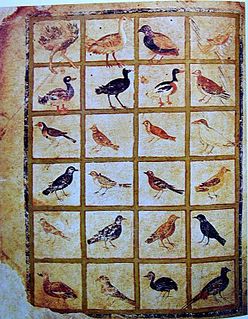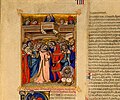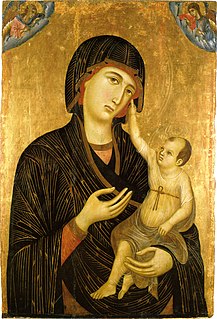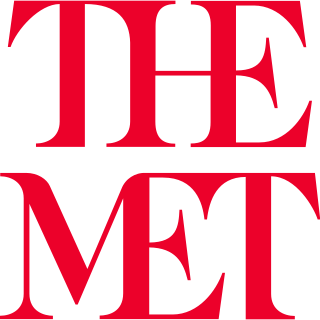
Giorgio Giulio Clovio or Juraj Julije Klović was an illuminator, miniaturist, and painter born in the Kingdom of Croatia, who was mostly active in Renaissance Italy. He is considered the greatest illuminator of the Italian High Renaissance, and arguably the last very notable artist in the long tradition of the illuminated manuscript, before some modern revivals.

The Walters Art Museum, located in Mount Vernon-Belvedere, Baltimore, Maryland, United States, is a public art museum founded and opened in 1934. It holds collections established during the mid-19th century. The Museum's collection was amassed substantially by major American art and sculpture collectors, a father and son: William Thompson Walters, (1819–1894), who began serious collecting when he moved to Paris as a nominal Southern/Confederate sympathizer at the outbreak of the American Civil War in 1861; and Henry Walters (1848–1931), who refined the collection and made arrangements for the construction of a later landmark building to rehouse it. After allowing the Baltimore public to occasionally view his father's and his growing added collections at his West Mount Vernon Place townhouse/mansion during the late 1800s, he arranged for an elaborate stone palazzo-styled structure built for that purpose in 1905–1909. Located across the back alley, a block south of the Walters mansion on West Monument Street/Mount Vernon Place, on the northwest corner of North Charles Street at West Centre Street.

A portrait miniature is a miniature portrait painting, usually executed in gouache, watercolor, or enamel. Portrait miniatures developed out of the techniques of the miniatures in illuminated manuscripts, and were popular among 16th-century elites, mainly in England and France, and spread across the rest of Europe from the middle of the 18th-century, remaining highly popular until the development of daguerreotypes and photography in the mid-19th century. They were usually intimate gifts given within the family, or by hopeful males in courtship, but some rulers, such as James I of England, gave large numbers as diplomatic or political gifts. They were especially likely to be painted when a family member was going to be absent for significant periods, whether a husband or son going to war or emigrating, or a daughter getting married.

The Vienna Dioscurides or Vienna Dioscorides is an early 6th-century Byzantine Greek illuminated manuscript of De Materia Medica by Dioscorides in uncial script. It is an important and rare example of a late antique scientific text. The 491 vellum folios measure 37 by 30 cm and contain more than 400 pictures of animals and plants, most done in a naturalistic style. In addition to the text by Dioscorides, the manuscript has appended to it the Carmen de herbis attributed to Rufus, a paraphrase of an ornithological treatise by a certain Dionysius, usually identified with Dionysius of Philadelphia, and a paraphrase of Nicander's treatise on the treatment of snake bites.

Joris Hoefnagel or Georg Hoefnagel was a Flemish painter, printmaker, miniaturist, draftsman and merchant. He is noted for his illustrations of natural history subjects, topographical views, illuminations and mythological works. He was one of the last manuscript illuminators and made a major contribution to the development of topographical drawing.

Benvenuto Tisi was a Late-Renaissance-Mannerist Italian painter of the School of Ferrara. Garofalo's career began attached to the court of the Duke d'Este. His early works have been described as "idyllic", but they often conform to the elaborate conceits favored by the artistically refined Ferrarese court. His nickname, Garofalo, may derive from his habit of signing some works with a picture of a carnation.

The Ambrosian Iliad or Ilias Picta is a 5th-century illuminated manuscript on vellum, and depicts the entirety of Homer's Iliad, including battle scenes and noble scenes. The Ambrosian Iliad is considered unique due to being the only set of ancient illustrations that depict scenes from the Iliad, and it is seen as an example of the transition from Greek oral tradition to the written word. The Ambrosian Iliad consists of 52 miniatures that are estimated to have been cut from their original manuscript before the 13th Century, each labeled numerically. Comparisons of texts per page to other late antique manuscripts has led some to speculate these miniatures were originally part of a large manuscript. This manuscript is unlike other illuminated manuscripts in its lack of gilding. Instead, the author(s) chose yellow ochre to represent gold within the individual images, i.e. the gold cuirasses of noble figures, and the halo of Zeus.

A Persian miniature is a small painting on paper, whether a book illustration or a separate work of art intended to be kept in an album of such works called a muraqqa. The techniques are broadly comparable to the Western and Byzantine traditions of miniatures in illuminated manuscripts. Although there is an equally well-established Persian tradition of wall-painting, the survival rate and state of preservation of miniatures is better, and miniatures are much the best-known form of Persian painting in the West, and many of the most important examples are in Western, or Turkish, museums. Miniature painting became a significant genre in Persian art in the 13th century, receiving Chinese influence after the Mongol conquests, and the highest point in the tradition was reached in the 15th and 16th centuries. The tradition continued, under some Western influence, after this, and has many modern exponents. The Persian miniature was the dominant influence on other Islamic miniature traditions, principally the Ottoman miniature in Turkey, and the Mughal miniature in the Indian sub-continent.

The Trecento was a period of vigorous activity in Italy in the arts, including painting, architecture, literature, and music. The music of the Trecento paralleled the achievements in the other arts in many ways, for example, in pioneering new forms of expression, especially in secular song in the vernacular language, Italian. In these regards, the music of the Trecento may seem more to be a Renaissance phenomenon; however, the predominant musical language was more closely related to that of the late Middle Ages, and musicologists generally classify the Trecento as the end of the medieval era. Trecento means "three hundred" in Italian but is usually used to refer to the 1300s. However, the greatest flowering of music in the Trecento happened late in the century, and the period is usually extended to include music up to around 1420.
The decade of the 15th century in art involved some significant events.

Martino di Bartolomeo or Martino di Bartolomeo di Biago was an Italian painter and manuscript illuminator active between 1389 and 1434. He was one of his generation's principal painters of the Sienese School. From specific aspects of his early style, he is believed to have trained in the studio of Taddeo di Bartolo. As a young man Martino collaborated with Giovanni di Pietro da Napoli in Pisa. The fresco cycle in the church of San Giovanni Battista di Cascina, outside Pisa, bears Martino’s signature, and the date 1398. He returned permanently to Siena in 1405; there he painted several prominent fresco cycles in the Duomo and the Palazzo Pubblico. Further official commissions for altarpieces and for polychromy of sculptures attest to his versatility and to his prestige as one of the city’s official artists.

Niccolò di Ser Sozzo was an Italian painter and manuscript illuminator. He generally has been identified as Niccolò di Ser Sozzo di Francesco Tegliacci, but recent research points instead to a Niccolò di Ser Sozzo di Stefano. Whatever his true identity, Niccolo was one of the leading panel painters and miniaturists at work in Siena in the mid-14th century. His style is closest to that of Lippo Vanni and his sometime collaborator Luca di Tomme and is ultimately dependent upon the tradition of Simone Martini and, especially, the Lorenzetti brothers, in whose workshop he may have apprenticed.
The decade of the 1320s in art involved some significant events.
Frà Niccolò da Poggibonsi was a Franciscan friar of the 14th century who made a famous pilgrimage to the Holy Land in 1345–50, which he described in Italian in his Libro d'oltramare.
Michelino Molinari da Besozzo was a notable fifteenth century Italian painter and illuminator, who was widely praised for his work. He worked mostly in Milan and Lombardy, and was employed by the Visconti family, rulers of Milan. Michelino's work follows the traditions of the Lombard School, and maintains the Trecento style.

The Hours of Giangaleazzo Visconti is a Roman-liturgy illuminated Book of Hours that was commissioned by the ruler of Milan, Gian Galeazzo Visconti, in Italy in the late 14th century. A Book of Hours is a personal prayer book that contained, in part, the Hours of the Virgin, a daily devotional that was popular at the time. This particular Book of Hours was created by two master illuminators, beginning with Giovannino dei Grassi before his death, and completed by Luchino Belbello da Pavia.

Niccolò di Pietro, also Niccolo di Pietro Veneziano, Niccolo Paradiso, was a Sienese School painter of Medieval art. The date of his birth and death are unknown.

Francesco di Antonio del Chierico (1433–1484) was a manuscript illuminator of the early Renaissance period in Florence. Francesco began as a goldsmith before changing occupations to become a successful illustrator. He was one of the pupils of Fra Angelico and became famous for being Lorenzo de' Medici's favorite illuminator. He worked under some of the most prestigious patrons of the time, including Lorenzo de' Medici, Piero de’ Cosimo de' Medici, Cosimo il Vecchio, and Vespasiano da Bisticci. He gained a reputation for his well executed illustrations in varying types of books ranging in size from small books of hours to large choir books. His illustrations often included intricate floral arrangements, putti, and candelabras. He decorated both the borders of manuscripts and full pages.






















